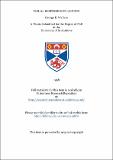Files in this item
Visual responses in locusts
Item metadata
| dc.contributor.advisor | Waterhouse, F. L. | |
| dc.contributor.author | Wallace, George Kydd | |
| dc.coverage.spatial | 136 p. | en_US |
| dc.date.accessioned | 2018-07-03T16:17:00Z | |
| dc.date.available | 2018-07-03T16:17:00Z | |
| dc.date.issued | 1958 | |
| dc.identifier.uri | https://hdl.handle.net/10023/14870 | |
| dc.description.abstract | The investigation reported here is concerned with the study of certain visual responses in the Desert Locust Schistocerca gregaria. (Forsis). It is a behaviour study. The aim is to form some idea of the kind of information which the Insect is obtaining by means of compound eyes and the way in which this is manipulated. II Form perception. a. In spontaneous choice experiments it is shown that nymphs of the Desert Locust are attracted to black objects on a white background and to the contour lines of these objects. The degree of contrast between the object and the background is important. On a white background the darker the object the more attractive it is. III. Peering. a. It is shown that the swaying of the front part of the body and the head from side to side, called peering, is a visual response. An apparatus is described for measuring the angle through which the head moves laterally with respect to the original position of the longitudinal axis of the body. IV. Antenna waving. a. Two main types of antenna movement are distinguished - flicking and beating. The former is a movement of one antenna usually occurring as the insect passes an object. The latter is the alternate movement of both antennae as the insect is approaching head-on and close to an object. b. Flicking: The antenna to be flicked is the one on the same side as the object and the response occurs when the edge of the object is seen by the more lateral part of the eye. In conjunction with the flicking, the antenna in question is often pointed at the object edge. c. Beating: This takes place at a short distance from an object (less than one inch), the distance being independent of the angle sub-tended by the object. V. Responses to movement. a. Fright response to the movement of a large object across the visual field. The response varies in intensity. At low intensity the insect tenses; at higher intensity the insect jerks; at the highest intensity observed the insect moves (backs or moves sideways) away from the object. The response decreases with increased distance. b. Optomotor response; The insects show an optomotor response to moving stripes. They follow the movement of the stripes. The stimulus is effective even when it only occupies a small part of the visual field and the insects respond to stripes moving from front to rear of the eye and from rear to front. Moving stripes stimulating the anterior part of the eye appear to have less effect in releasing the optomotor response than when stimulating the lateral parts of the eye. The insects walk toward a steady movement of stripes in front of them. If the stripe movement is intermittent the insects show the fright response. VI. Discussion. The results of all the experiments are discussed and a system proposed whereby the insect responds to the stimulation of the visual receptors produced by the movement of the images of contours over the retina. The properties of the system are discussed well as the behaviour which would be expected as the results of these. A comparison is then made with the behaviour observed in the present investigation. One possible way in which such a system could be elaborated is briefly considered. VII. Conclusion. The conclusion is reached that, although the work has dealt with only few of the visual responses of these insects, sufficient information has been obtained to show that the insects possess a highly developed visual sense, that their compound eyes are quite efficient navigating instruments and that visual responses play a large part in the total behaviour repertoire, The analyses of the stimuli involved in each response studied gives some insight into the nature of this insect's visual environment. | en_US |
| dc.language.iso | en | en_US |
| dc.publisher | University of St Andrews | |
| dc.subject.lcc | QL508.A2W2 | en |
| dc.subject.lcsh | Locusts | en |
| dc.title | Visual responses in locusts | en_US |
| dc.type | Thesis | en_US |
| dc.contributor.sponsor | Carnegie Trust for the Universities of Scotland | en_US |
| dc.contributor.sponsor | Cross Trust | en_US |
| dc.type.qualificationlevel | Doctoral | en_US |
| dc.type.qualificationname | PhD Doctor of Philosophy | en_US |
| dc.publisher.institution | The University of St Andrews | en_US |
This item appears in the following Collection(s)
Items in the St Andrews Research Repository are protected by copyright, with all rights reserved, unless otherwise indicated.

